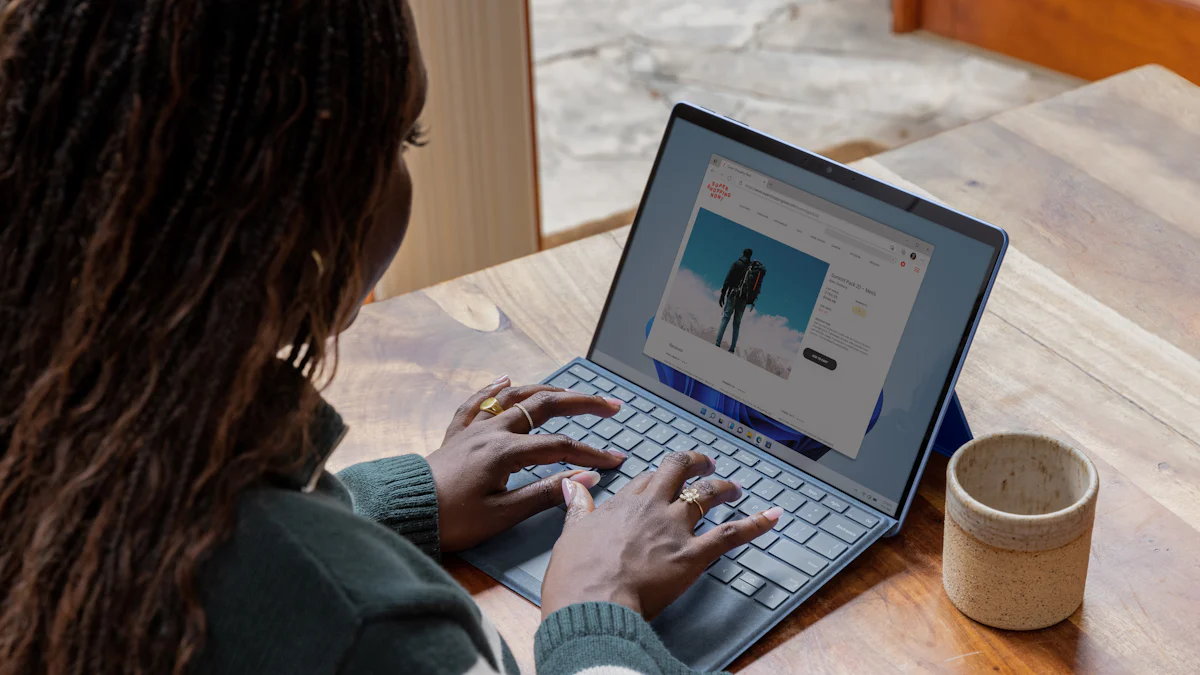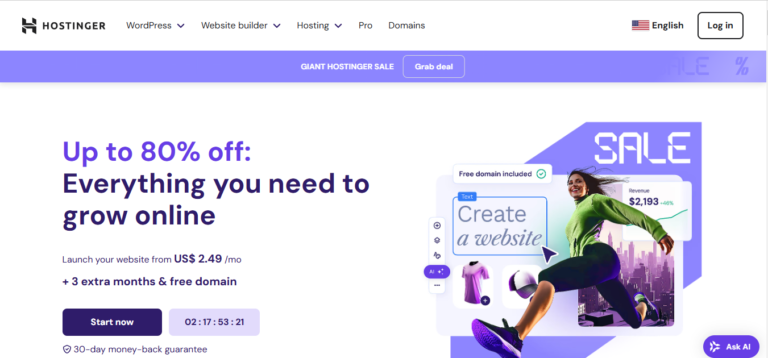Book Appointment Now

How to Start a Blog in 2025: A Beginner’s Step-by-Step Guide
Blogging in 2025 is bigger than ever. Did you know that 7.5 million blog posts are published daily?
With over 409 million people viewing 20 billion pages each month on WordPress.com, the opportunities are endless.
Whether you want to share your passion, build your brand, or earn an income, blogging can open doors you never imagined.
It’s not just about writing; it’s about creating connections and making your voice heard.
So why wait?
Take the leap, create a blog, and start your journey today. The world is ready for your story!
Choose a Blog Name and Niche

Importance of Picking the Right Niche
Choosing the right niche is the foundation of your blogging success. It’s what sets the tone for your content and attracts the right audience.
But how do you pick the perfect niche? Start by asking yourself three key questions:
Who do you want to write for?
What topics excite you?
Can this niche generate income?
Here’s a quick checklist to guide you:
- Specify your audience. Think about who you want to help or inspire.
- Identify your interests and expertise. Writing about something you love makes blogging enjoyable.
- Research profitability. Look for niches with demand and opportunities for monetization.
Some popular niches include health and fitness, parenting, budget travel, and green living. For example, blogs like Fit Bottomed Girls and The Good Trade have built loyal audiences by focusing on specific, in-demand topics.
How to Brainstorm a Memorable Blog Name
Your blog name is your brand. It’s the first thing people notice, so make it count! A great blog name is catchy, easy to remember, and reflects your niche.
Here are some creative examples and how they were crafted:
| Blog Name | Creation Strategy |
|---|---|
| Love. Life. Yarn. | Inspired by the phrase ‘Live. Laugh. Love.’, with a clever twist. |
| Repeat Crafter Me | A fun pun that highlights the blog’s focus on crafting. |
| Fluent in 3 Months | A bold promise that grabs attention in the language-learning niche. |
When brainstorming, play with words, use puns, or combine ideas. Keep it simple and unique.
Validating Your Niche for Success
Before you dive in, make sure your niche has potential. Validation helps you avoid wasting time on a topic that won’t gain traction.
Here’s how you can validate your niche:
- Check if people are searching for your topic. Use tools like Google Trends or AnswerThePublic.
- Look at competitors. Are there successful blogs in your niche? That’s a good sign!
- Test your idea. Share a few posts on social media to see how people respond.
Avoid common mistakes like picking a niche you know nothing about or thinking you need to be an expert. Blogging is a journey, and you’ll learn as you go.
By choosing the right niche and name, you’re setting yourself up for success. Now, it’s time to create a blog and share your passion with the world!
Set Up Hosting and Domain
Understanding Hosting and Domain Basics
Before you can create a blog, you need two essential things: hosting and a domain name.
Think of hosting as the home where your blog lives, and the domain as your blog’s address on the internet.
Without these, your blog won’t have a place to exist or a way for people to find it.
There are three main types of hosting you’ll come across:
- Shared Hosting: This is like sharing an apartment with roommates. It’s affordable and beginner-friendly, but you’ll share resources with other websites.
- VPS Hosting: Imagine having your own private room in a shared house. You get more space and better performance, but it’s still not entirely yours.
- Dedicated Hosting: This is like owning your own house. You have full control and excellent performance, but it’s more expensive and requires technical know-how.
For most beginners, shared hosting is the best starting point. It’s cost-effective and easy to manage while you’re learning the ropes.
Choosing the Best Hosting Provider in 2025
Picking the right hosting provider is crucial. You want a service that’s reliable, affordable and aligns with your values. Here are some trends to keep in mind when choosing:
- Many hosting companies now offer eco-friendly options, perfect if you care about sustainability.
- Reliability is a top priority. Look for providers with strong uptime guarantees (99.9% or higher).
- Hosting prices are more competitive than ever, so you can find great deals without breaking the bank.
Some popular hosting providers include Bluehost, SiteGround, Hostinger, and GreenGeeks. Each offers beginner-friendly plans and excellent customer support.
Step-by-Step Guide to Registering Your Domain
Registering your domain is easier than you think. Follow these simple steps:
- Choose a Domain: Decide on a name that reflects your blog’s niche and brand. On the registration screen, select “Register a new domain.”
- Search for Domains: Enter your desired name and check if it’s available. If it’s taken, try slight variations or different extensions like .net or .blog.
- Register Your Domain: Once you find an available name, complete your account details and payment to secure it.
Pro Tip: Keep your domain name short, memorable, and easy to spell. This makes it easier for readers to find you online.
With your hosting and domain set up, you’re one step closer to launching your blog. Next, you’ll learn how to install and customize WordPress to bring your vision to life!
Install and Customize WordPress
Why WordPress Is Ideal for Beginners
If you’re new to blogging, WordPress is the perfect platform to get started. It’s versatile, user-friendly, and packed with features that make creating your blog a breeze. Here’s why so many beginners love WordPress:
- It’s free to use, so you can start without spending a dime.
- You can customize your blog to match your style and vision.
- The platform is easy to learn, even if you’re not tech-savvy.
- A huge community of users and developers is ready to help if you get stuck.
- Full site editing tools let you design your blog exactly how you want.
With WordPress, you’re not limited to just blogging. You can expand into other areas like e-commerce or portfolio sites as your skills grow.
Quick Steps to Install WordPress
Installing WordPress might sound intimidating, but it’s actually super simple. Follow these steps, and you’ll be up and running in no time:
- Log in to Your Hosting Account: Most hosting providers have a one-click WordPress installation option.
- Find the WordPress Installer: Look for a section like “Website” or “WordPress Tools.”
- Run the Installer: Click “Install” and fill in details like your blog name and admin credentials.
- Access Your Dashboard: Once installed, log in to your WordPress dashboard at
yourdomain.com/wp-admin.
That’s it! You’re now ready to start customizing your blog.
Customizing Your Blog’s Design and Features
This is where the fun begins. WordPress makes it easy to design a blog that feels uniquely yours. Start by choosing a theme that fits your niche. Thousands of free and premium themes are available, so you’ll find one that matches your style.
Here are some best practices for customization:
- Use colors and fonts that reflect your brand.
- Add images and videos to make your blog visually appealing.
- Keep the layout simple and easy to navigate.
- Ensure your design works well on mobile devices.
- Install plugins to add features like contact forms or social media sharing.
By following these steps, you’ll create a blog that not only looks amazing but also provides a great experience for your readers.
Create Foundational Content
What Foundational Content Is and Why It Matters
Foundational content is the backbone of your blog. It’s the first impression you make on your readers and sets the tone for everything you create.
Think of it as the essential building blocks that establish your blog’s credibility and purpose.
Why does it matter so much?
Foundational content solves problems for your audience. It positions you as an authority in your niche and keeps readers coming back for more.
When your posts are informative, engaging, and helpful, they attract traffic and encourage shares.
This is how you build trust and grow your audience.
Tip: Use catchy headlines to grab attention. A great headline can make the difference between someone clicking on your post or scrolling past it.
Examples of Must-Have Blog Posts
Not sure where to start? Here are some examples of foundational blog posts that can inspire you:
- How-To Guides: Posts like “10 Ways to Drive Traffic to Your Blog Right Now” or “How Often Should You Really Be Working Out – And How Hard” are practical and valuable.
- Personal Stories: Sharing experiences, like “Why We’re Moving Back to America,” helps you connect with readers on a deeper level.
- Lists and Resources: Posts such as “20 Easy Healthy Meal Prep Lunch Ideas for Work” or “These Are the Best Kept Secrets in Europe” are highly shareable and useful.
- Inspirational Content: Highlighting success stories, like “5 Inspiring Bloggers (And How They Make Money),” motivates your audience and builds trust.
These types of posts are not only interesting but also establish your blog as a go-to resource in your niche.
Writing Engaging and Valuable Content
Creating engaging content doesn’t have to be complicated. Focus on solving problems and adding value to your readers’ lives. Here’s how you can do it:
- Be Authentic: Write in your own voice. Readers appreciate honesty and relatability.
- Keep It Simple: Avoid jargon and write in a way that’s easy to understand.
- Add Visuals: Use images, infographics, or videos to make your posts more appealing.
- Encourage Interaction: Ask questions or invite readers to share their thoughts in the comments.
Remember, your goal is to create a blog that people love to visit. When your content is both engaging and valuable, you’ll build a loyal audience in no time.
Develop a Content Strategy
Planning Your Blog’s Content Calendar
A content calendar is your secret weapon for staying organized and consistent. It helps you plan what to publish and when, so you’re never scrambling for ideas at the last minute. Plus, it keeps your blog aligned with your goals.
Why should you bother with a content calendar? Here’s what you gain:
- Increased efficiency. You’ll spend less time brainstorming and more time creating.
- More traffic. A steady stream of content keeps readers coming back.
- Better goal tracking. You can measure what works and adjust your strategy.
To get started, use tools like ClickUp, Trello, or Notion. These platforms let you schedule posts, track deadlines, and even collaborate if you’re working with others.
If you prefer simplicity, try a WordPress Editorial Calendar plugin. It’s perfect for managing your posts directly on your blog.
Researching Blog Topics Effectively
Finding the right topics is key to keeping your audience engaged. But how do you know what they want to read? Start by using tools like Semrush or AnswerThePublic to discover trending topics and keywords. These tools show you what people are searching for, so you can tailor your content to their needs.
Another great strategy is to analyze your existing posts. Look at what’s performed well and create similar content. For example, if a how-to guide got a lot of views, consider writing another one on a related topic.
Don’t forget to check out your competitors.
Their popular posts can inspire fresh ideas for your blog.
Staying Consistent with Your Blogging Schedule
Consistency is the backbone of a successful blog.
When you post regularly, you build trust with your readers and improve your site’s performance.
Did you know websites with blogs have 434% more indexed pages? That means more chances for people to find you online.
Here’s how to stay consistent:
- Set realistic goals. Start with one or two posts a week and increase as you get comfortable.
- Use a content calendar to plan ahead. This keeps you on track and reduces stress.
- Write in batches. Create multiple posts at once to save time.
Remember, consistency isn’t just about frequency. It’s also about quality. Focus on delivering valuable content every time you create a blog post.
Optimize and Promote Your Blog
Beginner-Friendly SEO Tips for 2025
Search Engine Optimization (SEO) might sound intimidating, but it’s easier than you think.
With the right strategies, you can make your blog more visible and attract readers. Here are some beginner-friendly SEO tips to get you started:
- Conduct keyword research to find low-competition, relevant keywords.
- Write high-quality content that solves your readers’ problems.
- Optimize on-page elements like meta titles, descriptions, and headers.
- Focus on mobile-first optimization since most users browse on their phones.
- Use schema markup to improve how your blog appears in search results.
- Build backlinks from reputable sites to boost your blog’s authority.
- Leverage AI tools to refine your content for better performance.
- Monitor your blog’s analytics to see what’s working and adjust accordingly.
Also, keep your blog easy to navigate. Use clear categories and tags to organize your posts. Short sentences and transition words can make your content more readable.
These small changes can make a big difference in how search engines rank your blog.
Using Social Media to Drive Traffic
Social media is a powerful tool to bring readers to your blog. Platforms like Instagram, Twitter, and Pinterest let you share your content with a wider audience. Here’s how you can use them effectively:
- Share your blog posts with eye-catching captions and visuals.
- Engage with your audience by replying to comments and messages.
- Use hashtags to make your posts discoverable.
- Collaborate with influencers in your niche to reach new readers.
- Post consistently to stay on your followers’ radar.
Social media isn’t just about promotion. It’s also a way to connect with your audience and build a community around your blog.
Building an Email List to Grow Your Audience
An email list is one of the most valuable assets for your blog. It lets you communicate directly with your readers and share updates, exclusive content, or promotions. Here’s why it’s worth the effort:
| Advantage | Description |
|---|---|
| Higher ROI | Email marketing offers a return of $38 for every $1 spent. |
| Higher Click-Through Rate | Emails are 6x more likely to get clicks than tweets. |
| Increased Sharing | Subscribers are more likely to share your content with others. |
| Purposeful List Building | Subscribers opt-in, meaning they’re genuinely interested in your content. |
| Lifelong Asset | Unlike social media, you own your email list. |
Start by adding a signup form to your blog. Offer a freebie like an eBook or checklist to encourage readers to subscribe.
Over time, your email list will become a reliable way to grow your audience and keep them engaged.
By optimizing your blog, promoting it on social media, and building an email list, you’ll set yourself up for long-term success.
These steps will help you create a blog that not only attracts readers but keeps them coming back for more.
Monetize Your Blog
Top Ways to Earn Money from Blogging
Once you’ve built your blog, it’s time to turn it into a money-making machine. Blogging in 2025 offers more opportunities than ever to earn income. Here are the top ways you can monetize your blog:
- Advertising: Display ads on your site through platforms like Google AdSense. You earn money every time someone views or clicks on an ad.
- Affiliate Links: Promote products or services and earn a commission for every sale made through your unique link.
- Sponsored Posts: Partner with brands to create content that promotes their products.
- Products: Sell digital or physical products directly to your audience.
- Services: Offer services like coaching, consulting, or freelance work.
Each method has its perks. Start with one or two options and expand as your blog grows.
Getting Started with Affiliate Marketing
Affiliate marketing is one of the easiest ways to start earning money. It’s perfect for beginners because you don’t need to create your own product. Here’s how you can get started:
- Find a product you love and want to promote.
- Search for the product’s affiliate program. Many companies have one listed on their website.
- Sign up for the program. Approval is usually quick and easy.
- Obtain your special tracking link. This link ensures you get credit for sales.
- Share the link on your blog or social media. Earn a commission for every sale made through it.
For example, if you create a blog about fitness, you could promote workout gear or supplements. Just make sure the products align with your niche and audience.
Creating and Selling Your Own Products
Selling your own products is one of the most profitable ways to monetize your blog. It gives you full control over pricing and branding. Here are some ideas based on popular niches:
| Niche | Monetization Strategies |
|---|---|
| Food | Sell printable cookbooks, partner with brands, or host live cooking classes. |
| Personal Development | Offer life-coaching sessions, sell digital journals, or launch a podcast. |
| Health and Fitness | Create workout videos, fitness courses, or offer one-on-one training. |
| Personal Finance | Develop online courses to teach financial skills or promote long-term investment products. |
Take inspiration from successful bloggers like Angela from Stray Curls, who earns $54K/year by selling creative resources. Or consider Sayan Neogie, who makes $114K/year with his personal finance blog. These stories prove that with the right strategy, you can turn your passion into profit.
By exploring these monetization methods, you’ll unlock the full potential of your blog. Whether you choose affiliate marketing, ads, or selling products, the key is to stay consistent and focus on providing value to your audience.
Starting a blog might feel overwhelming, but you’ve got everything you need to succeed.
Take that first step today and create a blog that reflects your passion. Remember, success doesn’t happen overnight.
It’s all about showing up, staying consistent, and putting in the effort.
Here’s what you should focus on as you begin:
- Pick a platform like WordPress to make blogging easy.
- Build connections by engaging with readers and other bloggers.
- Share valuable content that keeps your audience coming back.
- Use social media to promote your blog and grow your reach.
Your voice matters, and the world is waiting to hear it. So, why wait? Start your blog now and make your mark!
FAQ
How much does it cost to start a blog?
Starting a blog can cost as little as $50-$100 per year. This covers hosting and a domain name. Many tools and platforms, like WordPress, offer free options to help you get started without breaking the bank.
Do I need to know coding to create a blog?
Nope! You don’t need coding skills. Platforms like WordPress let you build and customize your blog with simple drag-and-drop tools. If you can click and type, you can create a blog.
How often should I post on my blog?
Consistency matters more than frequency. Start with one or two posts a week. Once you’re comfortable, increase your output. The key is to stick to a schedule your readers can rely on.
Can I blog about more than one topic?
Yes, but it’s better to focus on a niche. A clear niche helps you attract a loyal audience. If you want to cover multiple topics, make sure they connect in some way, like lifestyle or personal growth.
How long does it take to make money from blogging?
It depends on your effort and strategy. Some bloggers earn within months, while others take a year or more. Focus on creating valuable content and building an audience first. Monetization will follow.
Read Also:



